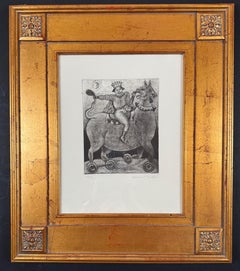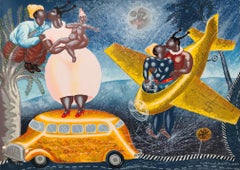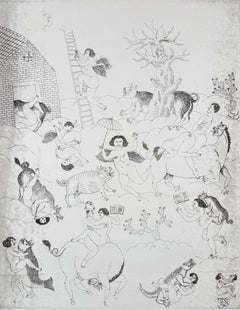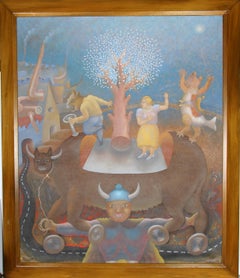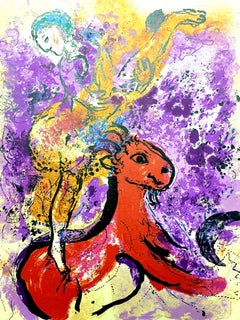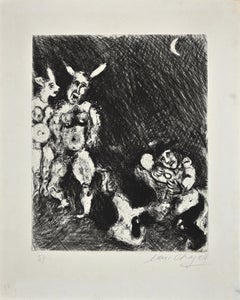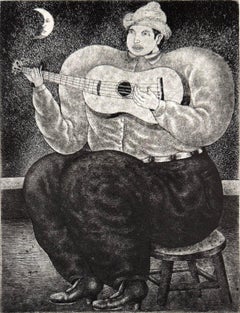Maximino Javier Art
Mexican, b. 1948
Maximino Javier (b. 1948) is a renowned Oaxacan artist recognized for his exploration of Latin American mythology in his art. He was a founding member of the Rufino Tamayo Workshop in Oaxaca, where he developed a distinct artistic approach emphasizing technical precision and cultural storytelling. His work often blends popular traditions with mythical narratives, employing meticulous use of color, form, and composition to transform folkloric themes into complex artistic statements.
Javier's art is known for its fantasy-oriented and whimsical nature, often featuring anthropomorphic elements and imaginative compositions, as seen in the expressive moon and stylized figures. His works frequently explore themes from Latin American mythology and the intricate relationship between humans and nature, reflected in the depiction of the musician and the moon in a mystical setting.
Unmistakable Iconography: Javier developed a unique and recognizable iconography, which is evident in the distinct forms and imaginative portrayal of characters and elements in these pieces, matching his unique aesthetic.to
2
1
1
Overall Width
to
Overall Height
to
3
1
1
2
2
1
3
1
4
3
3
1
1
1
1
1
1
1
2
2
1
1
1
4
9,743
2,739
1,368
1,366
2
4
Artist: Maximino Javier
untitled (horseman)
By Maximino Javier
Located in Palm Springs, CA
This whimsical and surreal etching by Mexican artist Maximino Javier, dated 1984, embodies his unique visual language that blends fantasy, folklore, and satire. Executed with intrica...
Category
1980s Contemporary Maximino Javier Art
Materials
Etching
Maximino Javier Mexican artist original hand signed silkscreen surrealism
By Maximino Javier
Located in Miami, FL
Maximino Javier (Mexico, 1948)
'Bajada de emergencia (serie Tamayo Total)', 2023
silkscreen on paper Canson 320 g.
20.3 x 28.2 in. (51.5 x 71.5 cm.)
Edition of 100
Unframed
ID: JAV-1...
Category
2010s Surrealist Maximino Javier Art
Materials
Cotton, Paper, Screen
El Jardin de las Delicias, by Maximino Javier
By Maximino Javier
Located in Palm Springs, CA
El Jardín de las Delicias by Maximino Javier was created in 1970. This date places it within a significant period of artistic exploration, reflecting the cultural and social themes p...
Category
1970s Surrealist Maximino Javier Art
Materials
Etching
Bull on Wheels (Dancing)
By Maximino Javier
Located in Long Island City, NY
An Oaxacan School oil painting by Maximino Javier from 1983. A whimsical scene of anthropomorphic figures. Framed in stained wood frame, signed in lower left corner.
Artist: Maximino Javier, Mexican (1948 - )
Title: Untitled - Bull on Wheels...
Category
1980s Folk Art Maximino Javier Art
Materials
Canvas, Oil
Price Upon Request
Related Items
Marc Chagall - The Red Rider - Original Lithograph
By Marc Chagall
Located in Collonge Bellerive, Geneve, CH
Marc Chagall - Original Lithograph
The Red Rider
From the unsigned, unnumbered lithograph printed in the literary review XXe Siecle
1957
See Mourlot 191
Dimensions: 32 x 24 cm
Publisher: G. di San Lazzaro.
Marc Chagall (born in 1887)
Marc Chagall was born in Belarus in 1887 and developed an early interest in art. After studying painting, in 1907 he left Russia for Paris, where he lived in an artist colony on the city’s outskirts. Fusing his own personal, dreamlike imagery with hints of the fauvism and cubism popular in France at the time, Chagall created his most lasting work—including I and the Village (1911)—some of which would be featured in the Salon des Indépendants exhibitions. After returning to Vitebsk for a visit in 1914, the outbreak of WWI trapped Chagall in Russia. He returned to France in 1923 but was forced to flee the country and Nazi persecution during WWII. Finding asylum in the U.S., Chagall became involved in set and costume design before returning to France in 1948. In his later years, he experimented with new art forms and was commissioned to produce numerous large-scale works. Chagall died in St.-Paul-de-Vence in 1985.
The Village
Marc Chagall was born in a small Hassidic community on the outskirts of Vitebsk, Belarus, on July 7, 1887. His father was a fishmonger, and his mother ran a small sundries shop in the village. As a child, Chagall attended the Jewish elementary school, where he studied Hebrew and the Bible, before later attending the Russian public school. He began to learn the fundamentals of drawing during this time, but perhaps more importantly, he absorbed the world around him, storing away the imagery and themes that would feature largely in most of his later work.
At age 19 Chagall enrolled at a private, all-Jewish art school and began his formal education in painting, studying briefly with portrait artist Yehuda Pen. However, he left the school after several months, moving to St. Petersburg in 1907 to study at the Imperial Society for the Protection of Fine Arts. The following year, he enrolled at the Svanseva School, studying with set designer Léon Bakst, whose work had been featured in Sergei Diaghilev's Ballets Russes. This early experience would prove important to Chagall’s later career as well.
Despite this formal instruction, and the widespread popularity of realism in Russia at the time, Chagall was already establishing his own personal style, which featured a more dreamlike unreality and the people, places and imagery that were close to his heart. Some examples from this period are his Window Vitebsk (1908) and My Fianceé with Black Gloves (1909), which pictured Bella Rosenfeld, to whom he had recently become engaged.
The Beehive
Despite his romance with Bella, in 1911 an allowance from Russian parliament member and art patron Maxim Binaver enabled Chagall to move to Paris, France. After settling briefly in the Montparnasse neighborhood, Chagall moved further afield to an artist colony known as La Ruche (“The Beehive”), where he began to work side by side with abstract painters such as Amedeo Modigliani and Fernand Léger as well as the avant-garde poet Guillaume Apollinaire. At their urging, and under the influence of the wildly popular fauvism and cubism, Chagall lightened his palette and pushed his style ever further from reality. I and the Village (1911) and Homage to Apollinaire (1912) are among his early Parisian works, widely considered to be his most successful and representative period.
Though his work stood stylistically apart from his cubist contemporaries, from 1912 to 1914 Chagall exhibited several paintings at the annual Salon des Indépendants exhibition, where works by the likes of Juan Gris, Marcel Duchamp and Robert Delaunay were causing a stir in the Paris art world. Chagall’s popularity began to spread beyond La Ruche, and in May 1914 he traveled to Berlin to help organize his first solo exhibition, at Der Sturm Gallery. Chagall remained in the city until the highly acclaimed show opened that June. He then returned to Vitebsk, unaware of the fateful events to come.
War, Peace and Revolution
In August 1914 the outbreak of World War I precluded Chagall’s plans to return to Paris. The conflict did little to stem the flow of his creative output, however, instead merely giving him direct access to the childhood scenes so essential to his work, as seen in paintings such as Jew in Green (1914) and Over Vitebsk (1914). His paintings from this period also occasionally featured images of the war’s impact on the region, as with Wounded Soldier (1914) and Marching (1915). But despite the hardships of life during wartime, this would also prove to be a joyful period for Chagall. In July 1915 he married Bella, and she gave birth to a daughter, Ida, the following year. Their appearance in works such as Birthday (1915), Bella and Ida by the Window (1917) and several of his “Lovers” paintings give a glimpse of the island of domestic bliss that was Chagall’s amidst the chaos.
To avoid military service and stay with his new family, Chagall took a position as a clerk in the Ministry of War Economy in St. Petersburg. While there he began work on his autobiography and also immersed himself in the local art scene, befriending novelist Boris Pasternak, among others. He also exhibited his work in the city and soon gained considerable recognition. That notoriety would prove important in the aftermath of the 1917 Russian Revolution when he was appointed as the Commissar of Fine Arts in Vitebsk. In his new post, Chagall undertook various projects in the region, including the 1919 founding of the Academy of the Arts. Despite these endeavors, differences among his colleagues eventually disillusioned Chagall. In 1920 he relinquished his position and moved his family to Moscow, the post-revolution capital of Russia.
In Moscow, Chagall was soon commissioned to create sets and costumes for various productions at the Moscow State Yiddish Theater, where he would paint a series of murals titled Introduction to the Jewish Theater as well. In 1921, Chagall also found work as a teacher at a school for war orphans. By 1922, however, Chagall found that his art had fallen out of favor, and seeking new horizons he left Russia for good.
Flight
After a brief stay in Berlin, where he unsuccessfully sought to recover the work exhibited at Der Sturm before the war, Chagall moved his family to Paris in September 1923. Shortly after their arrival, he was commissioned by art dealer and publisher Ambroise Vollard to produce a series of etchings for a new edition of Nikolai Gogol's 1842 novel Dead Souls. Two years later Chagall began work on an illustrated edition of Jean de la Fontaine’s Fables, and in 1930 he created etchings for an illustrated edition of the Old Testament, for which he traveled to Palestine to conduct research.
Chagall’s work during this period brought him new success as an artist and enabled him to travel throughout Europe in the 1930s. He also published his autobiography, My Life (1931), and in 1933 received a retrospective at the Kunsthalle in Basel, Switzerland. But at the same time that Chagall’s popularity was spreading, so, too, was the threat of Fascism and Nazism. Singled out during the cultural "cleansing" undertaken by the Nazis in Germany, Chagall’s work was ordered removed from museums throughout the country. Several pieces were subsequently burned, and others were featured in a 1937 exhibition of “degenerate art” held in Munich. Chagall’s angst regarding these troubling events and the persecution of Jews in general can be seen in his 1938 painting White Crucifixion.
With the eruption of World War II, Chagall and his family moved to the Loire region before moving farther south to Marseilles following the invasion of France. They found a more certain refuge when, in 1941, Chagall’s name was added by the director of the Museum of Modern Art (MOMA) in New York City to a list of artists and intellectuals deemed most at risk from the Nazis’ anti-Jewish campaign. Chagall and his family would be among the more than 2,000 who received visas and escaped this way.
Haunted Harbors
Arriving in New York City in June 1941, Chagall discovered that he was already a well-known artist there and, despite a language barrier, soon became a part of the exiled European artist community. The following year he was commissioned by choreographer Léonide Massine to design sets and costumes for the ballet Aleko, based on Alexander Pushkin’s “The Gypsies” and set to the music of Pyotr Ilyich Tchaikovsky.
But even as he settled into the safety of his temporary home, Chagall’s thoughts were frequently consumed by the fate befalling the Jews of Europe and the destruction of Russia, as paintings such as The Yellow Crucifixion...
Category
1950s Surrealist Maximino Javier Art
Materials
Lithograph
$2,894
H 12.6 in W 9.45 in D 0.04 in
Le Satyre et le Passant - Etching by Marc Chagall - 1927/30
By Marc Chagall
Located in Roma, IT
Etching and drypoint on Montreal paper, belonging to the suite "Les Fables de La Fontaine" (table n.57). Published in 1952.
Edition of 200, m...
Category
1950s Surrealist Maximino Javier Art
Materials
Etching
$4,489
H 16.34 in W 14.97 in D 0.08 in
Marc Chagall - The Candlestick - Original Lithograph
By Marc Chagall
Located in Collonge Bellerive, Geneve, CH
The Candlestick, from Jean Leymarie, Vitraux pour Jérusalem (Jerusalem Windows), André Sauret, Monte Carlo, 1962 (see M. 366-72; see C. books ...
Category
1960s Surrealist Maximino Javier Art
Materials
Lithograph
$2,481
H 12.8 in W 9.65 in D 0.04 in
Father Christmas
Located in Wilton Manors, FL
Beautiful original Folk Art painting by American artist, Arthur Glazier (1928-2015).
Oil on canvas, measuring 14 x 18 inches.
Signed lower bottom.
Arthur was born May 29, 1928, ...
Category
1970s Folk Art Maximino Javier Art
Materials
Canvas, Oil
Salvador Dali - Corrida - Vintage Poster with Etching
By Salvador Dalí
Located in Collonge Bellerive, Geneve, CH
Salvador Dali - Corrida - Vintage Poster with Etching
Etching made behind a menu in Restautant Duran as a tribute dinner to Salvador Dali and his wife Ga...
Category
1960s Surrealist Maximino Javier Art
Materials
Etching
Mississippi River Landscape
By Saul Haymond
Located in Lake Worth Beach, FL
Landscape Mississippi River.
Saul Haymond, Sr. (1947- ) of Pickens, Mississippi is a self-taught painter who has been documenting life in the African American community in Holmes Co...
Category
1960s Outsider Art Maximino Javier Art
Materials
Canvas, Oil
19th century American Folk Art of a Seated Lady in her Sunday best clothes
Located in Woodbury, CT
Unknown Artist (American School, 19th century)
Portrait of a Lady in Blue, c. 1835–1850
Oil on canvas
This painting is unsigned
This quietly elegant portrait captures a mature woman...
Category
1850s Folk Art Maximino Javier Art
Materials
Canvas, Oil
Whimsical French Folk Art, Naive, Oil Painting Madeline Marie Christine Clavier
By Madeline Christine Clavier
Located in Surfside, FL
MADELINE CHRISTINE CLAVIER (1913-2015)
Signature: Signed lower right & titled verso
Medium: Oil on canvas
Provenance: The collection of the artist's family
Marie Christine Clavier was born in Saigon, Vietnam in 1913 to French parents and lived there for her formative years. She returned to France as a teenager and began to study painting. Her work quickly developed into whimsical paintings of poetry and songs – harmonized in a unique and distinct painting technique. Her work has an impasto feel and a folk art, outsider artist sensibility to it. Similar in style to Maik and other fantasy realists who use animals, flowers and foliage in their artworks. Marie Clavier painted ro herself rather than for profit as she was quite independently wealthy. She exhibited extensively in the United States in the 1970s especially across Connecticut and New York, showing at various galleries and cultural centres. She had numerous solo exhibitions in the 1970’s- notably at the Maison Francaise in New York and New York University. She showed at Galerie Bernheim Jeune in Paris. She won many awards for her work including Gold Medals and Palme D’Or medals. In 1988 the prestigious art publisher Leopard D’Or produced catalogue book on her life and work – by this point she had virtually given up painting. She died in 2015 aged 102.
Bernheim-Jeune gallery is one of the oldest art galleries in Paris. Opened on Rue Laffitte in 1863 by Alexandre Bernheim (1839-1915), friend of Delacroix, Corot and Courbet, it changed location a few times before settling on Avenue Matignon. The gallery promoted realists, Barbizon school paintings and, in 1874, the first impressionist and later post-impressionist painters. It closed in 2019. In 1901, Alexandre Bernheim, with his sons, Josse (1870-1941), and Gaston (1870-1953), organized the first important exhibition of Vincent van Gogh paintings in Paris with the help of art critic Julien Leclercq. In 1906, Bernheim-Jeune frères started presenting works by Pierre Bonnard, Edouard Vuillard, Paul Cezanne, Henri-Edmond Cross, Kees van Dongen, Henri Matisse, Le Douanier Rousseau, Raoul Dufy, Maurice de Vlaminck, Amedeo Modigliani, Maurice Utrillo and Georges Dufrenoy. From 1906 to 1925, art critic Félix Fénéon was the director of the gallery and was instrumental in bringing in the art of Georges Seurat and Umberto Boccioni.
In 1922, an exhibition brought together works by Alice Halicka, Auguste Herbin, Pierre Hodé, Moise Kisling, Marie Laurencin, Henri Lebasque, Fernand Leger and Henri Matisse. The gallery now exhibits painters and sculptors in the tradition of the École de Paris and artists such as Jean Carzou, Shelomo Selinger or Pollès.
Her style is a recognizable, cheerful, whimsical and a happy creation. Naïve art is any form of visual art that is created by a person who lacks the formal education and training that a professional artist undergoes (in anatomy, art history, technique, perspective, ways of seeing). Unlike folk art, naïve art does not necessarily evince a distinct cultural context or tradition. Naïve art is recognized, and often imitated, for its childlike simplicity and frankness. Paintings of this kind typically have a flat rendering style with a rudimentary expression of perspective.
One particularly influential painter of "naïve art" was Henri Rousseau (1844–1910), a French Post-Impressionist who was discovered by Pablo Picasso. Naïve art is often seen as outsider art that is by someone without formal (or little) training or degree. While this was true before the twentieth century, there are now academies for naïve art. Naïve art is now a fully recognized art genre, represented in art galleries worldwide. Museums devoted to naïve art now exist in Kecskemét, Hungary; Riga, Latvia; Jaen, Spain; Rio de Janeiro, Brasil; Vicq France and Paris. Another term related to (but not completely synonymous with) naïve art is folk art. There also exist the terms "naïvism" and "primitivism" which are usually applied to professional painters working in the style of naïve art (like Paul Gauguin, Mikhail Larionov, Paul Klee). At all events, naive art can be regarded as having occupied an "official" position in the annals of twentieth-century art since - at the very latest - the publication of the Der Blaue Reiter, an almanac in 1912. Wassily Kandinsky and Franz Marc, who brought out the almanac, presented 6 reproductions of paintings by le Douanier' Rousseau (Henri Rousseau), comparing them with other pictorial examples. However, most experts agree that the year that naive art was "discovered" was 1885, when the painter Paul Signac became aware of the talents of Henri Rousseau and set about organizing exhibitions of his work in a number of prestigious galleries. The Earth Group (Grupa Zemlja) were Croatian artists, architects and intellectuals active in Zagreb from 1929 to 1935. The group included the painters Krsto Hegedušić, Edo Kovačević, Omer Mujadžić, Kamilo Ružička, Ivan Tabaković, and Oton Postružnik, the sculptors Antun Augustinčić, Frano Kršinić, and the architect Drago Ibler. A term applied to Yugoslav (Croatian) naive painters working in or around the village of Hlebine, near the Hungarian border, from about 1930. Some of the best known naive artists are Dragan Gaži, Ivan Generalić, Josip Generalić, Krsto Hegedušić, Mijo Kovačić, Ivan Lacković-Croata, Franjo Mraz, Ivan Večenaj and Mirko Virius. Camille Bombois (1883–1970) Ferdinand Cheval, known as 'le facteur Cheval' (1836–1924) Henry Darger (1892–1973) L. S. Lowry (1887–1976) Grandma Moses, Anna Mary Robertson...
Category
20th Century Folk Art Maximino Javier Art
Materials
Canvas, Oil
“Boy with Blue Birds”
By Agapito Labios
Located in Southampton, NY
Original oil on canvas folk art painting by the well known Mexican artist, Agapito Labios. Signed lower right. Circa 1935. Condition is very good. ...
Category
1930s Folk Art Maximino Javier Art
Materials
Canvas, Oil
The corridor of Katmandu, from The Hippies
By Salvador Dalí
Located in Washington, DC
Artist: Salvador Dali
Title: The corridor of Katmandu
Portfolio: The Hippies
Medium: Etching on Arches wove paper
Date: 1969
Edition: Unnumbered proof
Frame Size: 34 1/4" x 27 1/2"
S...
Category
1960s Surrealist Maximino Javier Art
Materials
Etching
"Simchat Torah in the Synagogue, " Leo Schutzman, Jewish Folk Art
By Leo Schutzman
Located in New York, NY
Leo Schutzman (1878 - 1962)
Simchat Torah in the Synagogue, circa 1958
Oil on canvas
40 x 36 inches
Signed lower left
Provenance:
The Contemporaries Gal...
Category
1950s Folk Art Maximino Javier Art
Materials
Canvas, Oil
Marc Chagall - The Ballet, Frontispiece
By Marc Chagall
Located in Collonge Bellerive, Geneve, CH
The Ballet, Frontispiece for the book “Daphnis and Chloe” Lithograph in colors, 1969. Unsigned and unnumbered, as issued from an edition of 10,000.
Printed ...
Category
1960s Surrealist Maximino Javier Art
Materials
Lithograph
Previously Available Items
The Guitar Player
By Maximino Javier
Located in Palm Springs, CA
This whimsical and surreal etching by Mexican artist Maximino Javier, dated 1984, embodies his unique visual language that blends fantasy, folklore, and satire.
Medium: Lithograph
...
Category
1980s Contemporary Maximino Javier Art
Materials
Etching
Maximino Javier art for sale on 1stDibs.
Find a wide variety of authentic Maximino Javier art available for sale on 1stDibs. If you’re browsing the collection of art to introduce a pop of color in a neutral corner of your living room or bedroom, you can find work that includes elements of blue and other colors. You can also browse by medium to find art by Maximino Javier in canvas, fabric, oil paint and more. Not every interior allows for large Maximino Javier art, so small editions measuring 40 inches across are available. Customers who are interested in this artist might also find the work of Jose Maria de Servin, Branko Bahunek, and Jaimendes. Maximino Javier art prices can differ depending upon medium, time period and other attributes. On 1stDibs, the price for these items starts at $125,000 and tops out at $125,000, while the average work can sell for $125,000.
